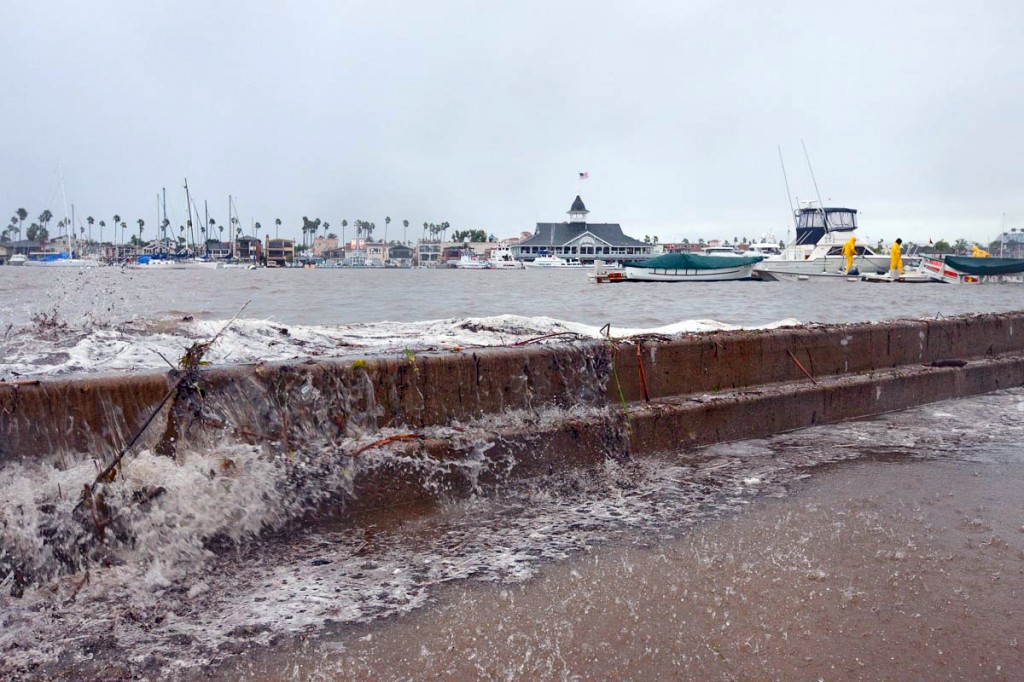
The city is building a seawall, or, rather, placing a cap on to extend the height of the current wall.
Newport Beach City council voted 6-0 Tuesday to add an approximate 9-inch concrete cap extension to the existing seawall on the north, south and west sides of Balboa Island. Councilman Jeff Herdman recused himself because of a real property interest.
The cap is a temporary measure as the city saves up funds to replace the aging sea walls. It’s a “band-aid” that can be very effective, Mayor Pro Tem Marshall “Duffy” Duffield said.
It’s an “awesome” project that has a lot of benefits, he said. It should have been done three years ago, he added.
“I’m very satisfied with this approach,” Duffield said. “I have no problems with it.”
Council members praised the plan, calling it simple and effective.
“We’re looking to make this easy and yet have a secure fix to the seawall,” said Assistant City Engineer Bob Stein.
Staff looked to little Balboa Island, where a cap has been installed for nearly 30 years, for inspiration for a short-term protection for the bigger island.
It should not compromise the structural integrity of the wall.
“Our evaluation did show that the wall is in good enough condition to be able to handle a 9-inch cap without destabilizing it,” Stein said.
The extra 9 inches would raise the top of the wall elevation to 8.5 feet on the north side and 9 feet on the south side (the side subject to storm winds and waves).
During high tides events, municipal operations staff closes the tide valves so the high tides don’t back up through the storm drains and onto the streets. Which works fine, unless it’s raining, Stein said. Any water caught on Balboa Island is not able to drain back out. The problem is exacerbated when waves are overtopping the seawall, he added.
This combination of actions, in essence, creates a pond on Balboa Island. City staff then have to pump all the water that has pooled up on the island streets over the seawalls and back into the ocean.
In this situation, the cap would do three things Stein explained: Prevent overtopping waves from contributing to the pooled water; limit the amount of water that has to be pumped back over the wall; and help protect staff working during the storms.
There would be closeable gaps to allow access to the public beaches and docks. Staff also want to maintain access to the beach for residents and visitors during construction.
Crews would work in sections and each area would take between 10 and 15 working days, Stein said. Construction is scheduled to begin in October and should take about 16 weeks to finish the work, with a break in December for the holidays, he estimated.
The engineer’s estimate for the project is between $1.5 and $2 million.
A couple of public speakers urged council members to look at the bigger picture.
Longtime Newport Beach resident and geologist Kathleen Andrews said she is passionate about climate change and called the seawall cap “necessary.”
It’s a good idea to start saving up for a larger project later, she added. The king tides and storm surges are becoming higher and more frequent, she said.
“We all know that the sea level is going to keep rising,” Andrews said.
Balboa Peninsula resident Craig Smith, who has experienced flooding in his neighborhood, commended the council for moving forward with the cap.
“I also think that’s not enough, that‘s a first step” Smith said. “That doesn’t address the basic causes.”
The city needs to address the root causes of climate change, he said.
He has studied the evidence and researched the issue extensively, he explained.
“I’m convinced that this is something real and it’s upon us,” Smith said.
Both agreed that the city needs to step up and take action to address the bigger issues.
This cap isn’t necessarily to address rising sea levels, Muldoon said.
“Although there is an argument that it’s very slowly rising, there is also the argument that last two years it’s been declining,” Muldoon said, This plan has “more to deal with currents and swells.”
Although he didn’t specifically say it was or wasn’t addressing sea level rise, Stein said that the extension cap would at least give the city some space for planning, if the sea levels were to rise in the next 10 years or so.
This will help the issue now and give time “so we can save up the money for the larger project and have a broader discussion with the community,” confirmed City Manager Dave Kiff.
This will provide time for the city to delve deeper into the discussion of the long-term plan to replace the seawalls, agreed Deputy Public Works Director and city engineer Mark Vukojevic. That could take many years, a much bigger budget and more involved construction that would go into the water. It’s much more complicated, Vukojevic added.
There are annual repairs of the seawall, patching an caulking any broken areas, Vukojevic pointed out. Looking toward the future, the big question is how to replace it and what to replace it with, he added.
Councilwoman Diane Dixon pointed out that the council previously discussed major repair and replacement plans for the seawall that would cost anywhere between $75 and $110 million. It was presented as being a much more imminent project.
“So we’re not there anymore apparently?” she asked.
“We’re satisfied with this approach right now,” Vukojevic answered.




